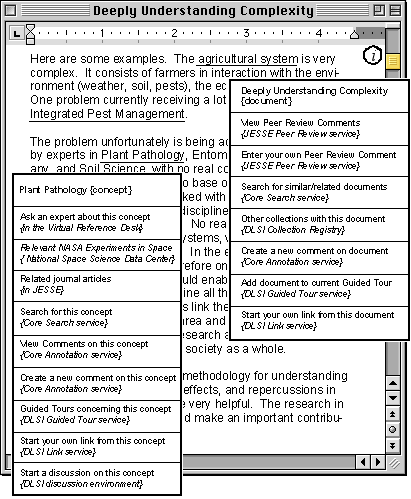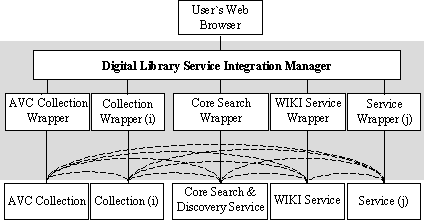Integrating Web Systems Through Linking
Xin Chen*, Dong-ho Kim**, Nkechi Nnadi*, Himanshu Shah*, Prateek
Shrivastava*, Michael Bieber*, Il Im* and Yi-Fang Wu*
*New Jersey Institute of Technology
University Heights, Newark, NJ 07102, USA
**Rutgers University Graduate School of Management
University Heights, Newark, NJ 07102, USA
http://is.njit.edu/dlsi/
ABSTRACT
This research provides a systematic approach for integrating Web
systems through linking interrelated elements and functions. The
infrastructure generates the vast majority of link anchors and links
automatically through the use of structural relationship rules, in
addition to lexical analysis.
Keywords
digital library, service integration, automatic link generation,
collaborative filtering, lexical analysis
INTRODUCTION AND MOTIVATION
This research provides a general method for integrating Web
systems through linking the interrelated elements and functions.
While our approach is a general one, we shall illustrate it using
digital libraries as our sample domain.
The purpose of the Digital Library Service Integration project
(DLSI) is to automatically generate links for digital library
collections to related collections and services. Collections are
libraries of computerized documents. Services include searching,
providing annotations and peer review. Figure 1 presents an example
of what users would see.
DLSI supplements collections by linking them automatically to
relevant services and related collections. DLSI supplements services
by automatically giving relevant objects in collections (and other
services) direct access to these services. Users see a totally
integrated environment, using their system just as before. However,
they will see additional link anchors, and when clicking on one, DLSI
will present a list of supplemental links. DLSI will filter and rank
order this set of generated links to user preferences and tasks.
The DLSI infrastructure provides a systematic approach for
integrating digital library systems, and by extension, any other
information system with a Web interface. Systems generally require no
changes to integrate with DLSI.

Figure 1: Mockup of a document with DLSI
support. DLSI automatically adds link anchors, including an icon in
the top right-hand corner for the document as a whole. Choosing one
prompts DLSI to generate a list of links. The figure superimposes two
possible sets of links for different elements: the concept "Plant
Pathology" and the document as a whole. Each link shows a descriptive
label, and the system to which it leads.
DLSI INFRASTRUCTURE AND INTEGRATION

Figure 2: DLSI Architecture. DLSI is within the
shaded area. The dashed paths indicate that once integrated,
collections and services can share features through DLSI links
automatically. Integrated systems also continue to operate
independently of DLSI.
Figure 2 presents the DLSI integration infrastructure. To
integrate a system, an analyst must write a wrapper, initiate
communications between the system and its wrapper, and define
relationship rules. (The DLSI Integration Manager module manages the
relationship rules.)
(1) Develop a Wrapper: The wrapper's main task is to parse
the display screens that appear on the user's Web browser to identify
the "elements of interest" that DLSI will make into link anchors.
First, wrappers will parse the display based on an understanding of
the structure of its content. Second, DLSI will parse the display
content using lexical analysis to identify additional elements of
interest. If a service can operate on an element, DLSI will generate
a link anchor over the element. Among the links generated for that
anchor will be a link leading directly to that service's feature.
(2) Develop Relationship Rules: Relationship rules specify
the "structural relationships" for automatically generating links for
recognized object types within the system being integrated.
(3) Initiate Communications: Several possible ways exist to
ensure information passes between the system being integrated and the
wrapper.
Most other kinds of information systems could be integrated in the
same manner as digital library collections and services.
AUTOMATIC LINK ANCHOR GENERATION: MUCH MORE THAN LEXICAL
ANALYSIS
We need to emphasize that DLSI generates the vast majority of link
anchors and links automatically. If a system can operate on an
element, DLSI will generate a link leading directly to that system's
feature. For example, if there were a discussion thread about a
course, any time that course's identifier would appear in a screen or
document, DLSI would automatically detect this and add an anchor over
the course identifier.
DLSI typically generates link anchors in two ways. First,
"wrappers" parse screens and documents based on an understanding of
the structure of the system's displays (i.e., using form templates,
XML markup or parsing rules). Most anchors are identified in this
manner.
Second, DLSI parses the screen and document content using lexical
analysis to identify additional anchors. DLSI generates links
automatically based on relationship rules.
RELATIONSHIP RULES
Relationship rules define which relationships (links) should be
available for which kinds of elements. For example, in Figure 1, the
relationship rule underlying the first concept link would include the
following parameters:
- the element type (in this case "concept")
- the link display label ("Ask an expert...")
- relationship metadata (semantic type, keywords, etc., useful
for filtering)
- the destination collection or service (in this case the
Virtual Reference Desk)
- the exact command to send to the destination system
- any relevant conditions for including this relationship
(including access restrictions)
Because they operate at the "class" or "kind of element" level,
each relationship rule works for every element of that class. E.g.,
the rule above applies to any "concept" found in any document
displayed.
Each relationship rule represents a single relationship for a
single element class. As elements can have many relationships, each
element class can have several relationship rules. Each element
instance triggers the same set of relationship rules, assuming
conditions are satisfied for each. In Figure 1, nine relationship
rules triggered for the "concept" element (or more rules triggered,
but the filtering mechanism produced this customized list).
DLSI INTEGRATION MANAGER
The DLSI Integration Manager uses the relationship rules to
determine which elements in a display will have links. The
Integration Manager then creates an integrated HTML or XML document
consisting of the original display output together with DLSI's
anchors, which it will send to the user's browser. When the user
selects an anchor, DLSI will use the relationship rules to generate a
list of relevant links. When the user selects one, the Integration
Manager passes the appropriate information to the appropriate
collection or service for that link.
The Integration Manager is built upon the Dynamic Hypermedia
Engine project [1, 2, 3].
LEXICAL ANALYSIS
DLSI wrappers perform lexical analysis when they parse documents
and display screens to determine additional "elements of interest,"
which the Integration Manager will supplement with DLSI link anchors.
Our Noun Phrase Extractor works this way: Tokenization is first
performed on the document or display screen. We then use the Wordnet
lexical database [http://www.cogsci.princeton.edu/~wn/]
to assign part-of-speech tags to tokens. Finally, a morphological and
syntactic rule base is used to parse sentences and extract noun
phrases. The Noun Phrase Extractor extracts noun phrases in their
root forms (this takes care of morphological changes) from returned
documents. These root form noun phrases are then separated into two
lists of phrases: those that are in the master thesaurus file and
those that are not. Any found in the master thesaurus will be made
into supplemental link anchors. Keywords and key phrases from
participating collections and services also will be added to this
integrated master file.
FILTERING AND RANK ORDERING
The number of potential links that DLSI could generate for a
particular element on a screen could vary from several to well over a
hundred, resulting in the well-known hypermedia problem of cognitive
overload. With a large number of links, filtering and ordering them
is critical for effective use. Filtering and rank ordering in DLSI
poses several challenges. First, it should be customized to each
user's needs. Second, it should dynamically re-organize as the users
advance through the system. Third, for the same user, support for
multiple needs must be possible. A user may have several different
tasks (needs) and the links should be re-organized depending on the
user's current task.
DLSI incorporates collaborative filtering to filter information
based on people's evaluations or behaviors. It generates
recommendations using the following algorithm [4, 5, 6]:
- Calculate degree of similarity ("similarity index") between
the current user and other users.
- Identify a group of people ("reference group") who appear to
share common interests with the current user. Their evaluations
(mouse clicks or "clickstreams") will be used for generating
recommendations for the current user.
- Calculate estimated evaluations for items that the current
user has not seen (or evaluated). An estimated evaluation predicts
the current user's evaluation on an item.
- Rank order the items according to the estimated evaluations
and select the top n items to recommend to the current user.
CONTRIBUTIONS
This research's primary contribution is providing a relatively
straightforward, sustainable infrastructure for integrating
information systems. Other contributions include:
- Developing filtering mechanisms for customizing large sets of
links to particular users.
- Combining automatically generated structural links and links
found through lexical analysis as a way of achieving
integration.
ACKNOWLEDGEMENTS
We gratefully acknowledge support by the NSF under grants
EISA-9818309, EIA-0083758, IIS-0135531 and DUE-0226075. DLSI is part
of the National Science Digital Library project (http://www.nsdl.org).
REFERENCES
- Bhaumik, Anirban, Deepti Dixit, Roberto Galnares, Manolis
Tzagarakis, Michalis Vaitis, Michael Bieber, Vincent Oria, Aparna
Krishna, Qiang Lu, Firas Aljallad, Li Zhang (2001). Integrating
Hypermedia Functionality into Database Applications. Developing
Quality Complex Database Systems: Practices, Techniques and
Technologies, Becker, Shirley (ed.)
- Bieber, M. (1998). Hypertext and Web Engineering. Proceedings
of the Ninth ACM Conference on Hypertext and Hypermedia, ACM
Press, 277-278.
- Galnares, R. (2001). Augmenting Applications with Hypermedia
Functionality and Metainformation. Ph.D. Thesis, New Jersey
Institute of Technology, Newark, NJ 07102.
- Herlocker, J. L., Konstan, J. A., Borchers, A., and Riedl, J.
"An Algorithmic Framework for Performing Collaborative Filtering,"
Proceedings of the 1999 Conference on Research and Development in
Information Retrieval, ACM Press, New York, NY, 1999.
- Im, Il and Hars, Alexander, "Finding information just for you:
Knowledge reuse using collaborative filtering systems,"
Proceedings of International Conference on Information Systems
(ICIS), New Orleans, Louisiana, 2001.
- Konstan, J. A., Miller, B. N., Maltz, D., Herlocker, J. L.,
Good, N., and Riedl, J. "GroupLens: Applying collaborative
filtering to Usenet news," Communications of the ACM, Mar 1997,
40(3), pp. 77-87.

